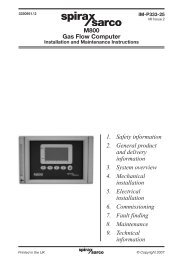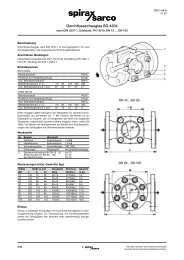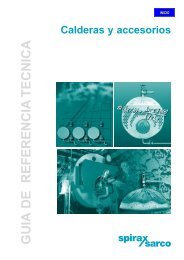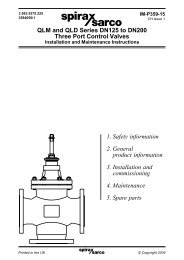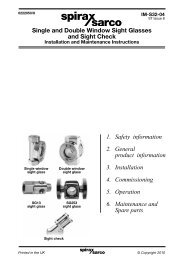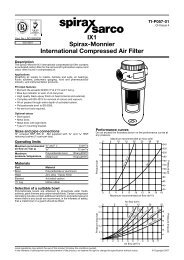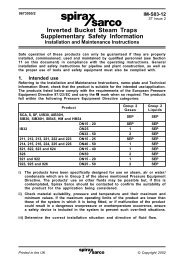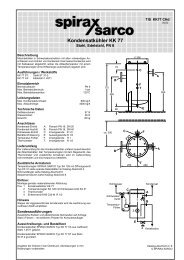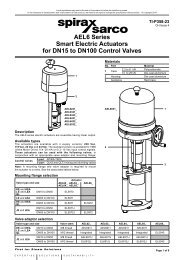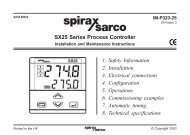2000 Hook-up Book - Spirax Sarco
2000 Hook-up Book - Spirax Sarco
2000 Hook-up Book - Spirax Sarco
Create successful ePaper yourself
Turn your PDF publications into a flip-book with our unique Google optimized e-Paper software.
SYSTEM DESIGN<br />
28<br />
Temperature Control Valves for Steam Service<br />
Steam Injector<br />
Unlike a sparge pipe, a steam<br />
injector is a manufactured device<br />
that draws in the cold liquid,<br />
mixes it with steam within the<br />
injector nozzle and distributes the<br />
hot liquid throughout the tank.<br />
Fine steam filtration in the preparation of cheese production is<br />
important to the quality of the final product. Because the producer<br />
of cheese products was heating cheese vat washdown<br />
water by direct steam injection, a filtration device was added<br />
to enhance product quality by filtering out the particulates.<br />
While pleased with this simple method of heating, there<br />
was some concern that any particulates entering the washdown<br />
water during steam injection may ultimately contaminate<br />
the vats being cleaned, affecting the cheese production.<br />
Solution<br />
Direct steam injection was the best solution for the cheese<br />
producer, but the concern about the contamination was<br />
very important.<br />
• A separator was installed in the incoming steam s<strong>up</strong>ply<br />
line, which removes a high percentage of the entrained<br />
moisture. A fine mesh screen strainer was installed to<br />
remove solid particulate matter.<br />
• A pneumatically actuated two port valve was installed to<br />
control tank temperature. The unit throttles the flow of<br />
steam to the tank based on the signal being transmitted<br />
by the temperature controller.<br />
• Having removed the entrained moisture and majority of particulate<br />
matter from the steam s<strong>up</strong>ply, a cleanable CSF16<br />
The circulation induced by the<br />
injector will help ensure thorough<br />
mixing and avoid temperature<br />
stratification. See Fig. II-43 (page<br />
105) for a typical injector installation.<br />
Other advantages of the<br />
Case in Action: Cheese Production<br />
Temperature Control Valves for Liquid Service<br />
Temperature control valves for liquid<br />
service can be divided into<br />
two gro<strong>up</strong>s. Normally associated<br />
with cooling, these valves can<br />
also be used on hot water.<br />
Direct Operated Valves<br />
Three types are available for liquid<br />
service and a selection would<br />
be made from one of the following<br />
styles.<br />
2-Port Direct-Acting.<br />
Normally open valve that the thermal<br />
system will close on rising<br />
temperature and used primarily<br />
for heating applications.<br />
2-Port Reverse-Acting.<br />
Normally closed valve which is<br />
opened on rising temperature.<br />
For use as a cooling control,<br />
valve should contain a continuous<br />
bypass bleed to prevent stagnate<br />
flow at sensor.<br />
3-Port Piston-Balanced.<br />
This valve is piped either for<br />
hot/cold mixing or for diverting<br />
flow between two branch lines.<br />
Pneumatically Operated<br />
Valves<br />
As with direct operated valves,<br />
the pneumatically operated types<br />
have the same three gro<strong>up</strong>s. The<br />
major difference is they require<br />
an external pneumatic or electric<br />
(through a positioner or converter)<br />
signal from a controller.<br />
Heating And Cooling Loads<br />
Formulas for calculating the heating<br />
or cooling load in gallons per<br />
minute of water are:<br />
Heating Applications:<br />
a. Heating water with water<br />
Heating water GPM required<br />
= GPM (Load) x TR<br />
∆T 1<br />
injector over a sparge pipe is<br />
reduced noise levels and the ability<br />
to use high pressure steam <strong>up</strong><br />
to 200 psig. Refer to applicable<br />
technical information sheets for<br />
sizing and selection information.<br />
stainless steel steam filter was installed which is capable of<br />
removing finer particles smaller than 5 microns in size.<br />
• A vacuum breaker was added to the system in order to<br />
prevent any of the heated water being drawn back <strong>up</strong><br />
into the filter during certain periods of operation.<br />
• A stainless steel injector system was installed which is<br />
capable of efficiently mixing large volumes of high<br />
pressure steam with the tank contents with little noise or<br />
tank vibration. (The customer stipulated the reduction of<br />
noise levels in the production facility.)<br />
Benefits:<br />
• Guaranteed steam purity and assured compliance with<br />
the 3-A Industry Standard<br />
• Inexpensive installation compared with alternative heat<br />
exchanger packages available<br />
• Cleanable filter element for reduced operating costs<br />
(replacement element and labor costs).<br />
• Accurate temperature control using components of the<br />
existing system<br />
• Quiet and efficient mixing of the steam and the tank contents<br />
• Product contamination is minimized, the cost of which<br />
could be many thousands of dollars, loss of production<br />
or even consumer dissatisfaction.<br />
b. Heating oil with water<br />
Heating water GPM required<br />
= GPM (Load) x TR<br />
2 X ∆T 1<br />
c. Heating air with water<br />
Heating water GPM required<br />
= CFM x TR<br />
400 x ∆T 1<br />
Cooling Applications:<br />
d. Cooling air compressor<br />
jacket with water<br />
Cooling Water GPM required<br />
= 42.5 x HP per Cylinder<br />
8.3 x ∆T 2<br />
Where:<br />
GPM = Gallons per minute water<br />
TR = Temperature rise of<br />
heated fluid, °F<br />
CFM = Cubic feet per minute Air<br />
∆T 1 = Temperature drop of<br />
heating water, °F<br />
∆T 2 = Temperature rise of<br />
cooling water, °F



